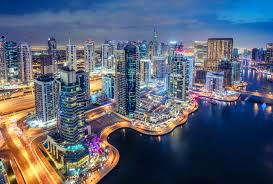Now Reading: UAE Real Estate: 7 New Residency Rules Driving Buyer Surge
-
01
UAE Real Estate: 7 New Residency Rules Driving Buyer Surge
UAE Real Estate: 7 New Residency Rules Driving Buyer Surge

Table of Contents
The UAE’s real estate market is experiencing unprecedented growth in 2025, fueled by seven new residency rules that are attracting a surge of international buyers, including those from the U.S. These investor-friendly policies, combined with the UAE’s tax-free environment and strategic location, are driving demand for properties in key areas like Dubai, Abu Dhabi, and Ajman. With transaction values reaching AED 115.6 billion ($31.5 billion) in Dubai alone in Q1 2025, these rules are reshaping the market, offering long-term residency and financial benefits. Below are the seven key residency rules boosting buyer interest.
1. Lowered Property Investment Threshold for Investor Visa

The minimum property investment for a 2-year investor visa has been reduced to AED 750,000 ($204,000) from AED 1 million ($272,000) in 2024. This change makes residency more accessible, particularly in affordable emirates like Ajman and Sharjah, where apartments start at AED 200,000 ($54,000). The lower threshold has driven a 23.9% increase in off-plan sales in Dubai, as first-time buyers capitalize on flexible payment plans.
2. Expanded Golden Visa Eligibility
The 10-year Golden Visa now applies to property investments of AED 2 million ($545,000) or more, with no requirement for full upfront payment. Buyers can purchase multiple properties or use mortgages to meet the threshold, broadening eligibility. In 2025, 13,000 new dollar millionaires joined the UAE, boosting demand for luxury properties in Palm Jumeirah and Saadiyat Island, where Golden Visa-linked sales surged 10-fold for homes over $2.72 million.
3. Freehold Ownership in New Zones
In January 2024, Dubai expanded freehold ownership to areas like Sheikh Zayed Road and Al Jaddaf, allowing all nationalities to own properties outright. This shift from leasehold to freehold status has increased buyer confidence, leading to a 44% rise in transaction values in May 2025 compared to 2024. Freehold properties are seen as more secure, attracting U.S. investors to high-demand areas like Dubai Marina.
4. Family Sponsorship for Property Owners

Property-based residency visas now allow holders to sponsor their spouse, children under 18, and, in some cases, parents, without additional investment. This rule, updated in 2025, appeals to family-oriented buyers, driving demand for villas in communities like Dubai Hills Estate and Aljada Sharjah. Villa prices rose 26% in 2024, reflecting this trend, with Ajman’s Sarab Garden Villas seeing a 20% price surge.
5. Renewable Residency for Off-Plan Properties
Buyers of off-plan properties valued at AED 750,000 ($204,000) or more can now secure renewable residency visas, even during construction, provided ownership is retained. This rule, introduced in 2024, has fueled a 741% surge in off-plan office sales in Dubai’s Q1 2025, as investors lock in residency early. Developments like Ajman Corniche Residences benefit, offering 6.6-8% ROI.
6. Residency for Retirees and Remote Workers
The UAE’s 5-year retirement visa, expanded in 2025, allows retirees over 55 with property investments of AED 1 million ($272,000) to gain residency. A similar visa for remote workers, introduced in 2023, has been streamlined, boosting demand for mid-tier apartments in areas like Jumeirah Village Circle, where sales jumped 169.7% in Q1 2023. These policies cater to U.S. professionals seeking flexible lifestyles.
7. Simplified Visa Renewal Process
The UAE has digitized and simplified visa renewals for property owners in 2025, allowing online processing via the Dubai Land Department’s smart platforms. This reduces bureaucratic hurdles, encouraging long-term investment. The policy supports a 18% increase in short-term rental demand, as investors rent out properties while maintaining residency, particularly in tourism hubs like Palm Jumeirah.
Why These Rules Appeal to American Investors
The UAE’s residency rules align with U.S. investor priorities: affordability, security, and high returns. Properties in Ajman Corniche offer 7-10% rental yields, while Dubai’s prime areas project 5-8% annual price growth. Freehold ownership and family sponsorship enhance long-term appeal, and the tax-free environment maximizes profits. The UAE’s proximity to global markets, with Dubai International Airport 30 minutes from key hubs, adds strategic value.
Market Outlook and Challenges
The UAE’s real estate market is set for an 8% CAGR through 2030, driven by these rules and infrastructure projects like the Dubai Loop. However, a potential 10-15% price correction in 2026 due to oversupply looms, particularly in Dubai. Stricter AML regulations also require enhanced due diligence, adding compliance costs for foreign buyers. U.S. investors should engage RERA-registered agents to navigate these challenges.
Conclusion
The seven new residency rules—lowered investment thresholds, expanded Golden Visas, freehold expansion, family sponsorship, off-plan residency, retiree/remote worker visas, and simplified renewals—are driving a buyer surge in the UAE’s real estate market. With high ROI, tax-free benefits, and vibrant communities like Ajman Corniche, these policies make the UAE a top destination for American investors in 2025. Residency Rules
read more: UAE Real Estate: 8 Corporate Tax Strategies for Property Companies





















